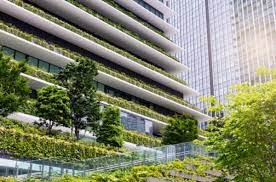The construction business is a major contributor to environmental degradation. According to the United Nations, buildings consume 40% of the world’s energy, emit 30% of greenhouse gases, and generate 40% of waste. Green building, also known as sustainable building, aims to reduce the environmental impact of construction by using energy-efficient technologies, renewable resources, and eco-friendly materials. This article will explore the future of green building and its impact on construction accounting.
The Rise of Green Building:
Green building has been gaining popularity in recent years, driven by a growing awareness of environmental issues, the need to reduce carbon emissions and expansion in the construction business. According to a report by Grand View Research, the global green building market size was valued at USD 262.5 billion in 2019 and is expected to grow at a compound annual growth rate (CAGR) of 11.0% from 2020 to 2027. This growth is attributed to several factors, including government regulations, corporate sustainability initiatives, and consumer demand for eco-friendly buildings.
Government Regulations:
Governments around the world are implementing regulations and incentives to encourage green building practices. These regulations and incentives create a market for green building materials and services, which in turn creates opportunities for construction companies.
Corporate Sustainability Initiatives:
Many corporations are adopting sustainability initiatives, including green building, as part of their corporate social responsibility (CSR) strategy. For example, Microsoft has pledged to be carbon negative by 2030 and has committed to making its buildings and data centers more energy-efficient. Walmart has committed to sourcing 50% of its electricity from renewable sources by 2025 and has implemented green building practices in its stores and distribution centers. These initiatives create demand for green building services, which can provide a competitive advantage for construction companies.
Consumer Demand:
Consumers are becoming more aware of environmental issues and are demanding eco-friendly products and services, including buildings. According to a survey by the National Association of Home Builders, 84% of homebuyers consider energy-efficient features to be “very important” or “essential” when searching for a home. This demand for green buildings creates a market for construction companies that specialize in sustainable building practices.
The Impact of Green Building on Construction Accounting:
Green building practices have a significant impact on construction accounting, particularly in the areas of cost accounting and financial reporting.
Cost Accounting:
Green building projects often require higher upfront costs, but these costs are often offset by long-term savings in energy and maintenance costs. Construction accountant must take these costs and savings into account when preparing project budgets and cash flow forecasts. For example, a green building project may require more expensive insulation or HVAC systems, but these costs may be offset by lower energy bills over the life of the building. Construction accountants must also be aware of the tax incentives and other financial benefits available for green building projects, as these can affect project profitability.
Financial Reporting:
Green building projects may require specialized financial reporting to comply with regulations and to provide investors and stakeholders with information about the project’s sustainability performance. For example, the Global Reporting Initiative (GRI) provides a framework for reporting on sustainability issues, including energy and emissions performance. Construction accountant must ensure that the project’s financial statements accurately reflect the project’s sustainability performance and comply with relevant regulations.
The Future of Green Building
The future of green building looks promising, as more companies and governments adopt sustainability initiatives and consumers demand eco-friendly buildings. Several trends are shaping the future of green building, including the use of renewable energy, the development of smart buildings, and the adoption of green building codes.
Renewable Energy:
Renewable energy is becoming more affordable and accessible, and is increasingly being used in green building projects. Solar panels, wind turbines, and geothermal systems can provide clean, renewable energy to power buildings, reducing reliance on fossil fuels. As the cost of renewable energy continues to decrease, it is expected to become a more common feature of green building projects.
Smart Buildings:
Smart buildings use technology to optimize energy use and enhance occupant comfort and safety. Building automation systems can monitor and control lighting, heating, and cooling systems, reducing energy waste and improving building performance. Sensors can detect changes in occupancy and adjust building systems accordingly. Smart buildings are also equipped with advanced security systems, enhancing occupant safety. As technology continues to advance, smart buildings are expected to become more prevalent in green building projects.
Green Building Codes:
Green building codes are regulations that set standards for building sustainability. These codes can require buildings to meet minimum standards for energy efficiency, water conservation, and indoor air quality, among other criteria. The adoption of green building codes is expected to increase, as governments around the world seek to reduce the environmental impact of buildings. Construction companies will need to stay up-to-date with these codes to ensure compliance and to provide competitive green building services.
Conclusion:
Green building is a growing trend in the construction industry, driven by government regulations, corporate sustainability initiatives, and consumer demand. Green building practices have a significant impact on construction accounting, particularly in the areas of cost accounting and financial reporting. Construction accountant must be aware of the costs and savings associated with green building projects, as well as the tax incentives and other financial benefits available. As the future of green building continues to evolve, construction companies will need to adapt to meet the demands of this growing market.
The adoption of renewable energy, the development of smart buildings, and the adoption of green building codes are just a few of the trends that are shaping the future of green building. By embracing these trends and providing innovative green building services, construction companies can position themselves for success in the evolving green building market. So, if you want to get competitive edge in the market, you can contact Foundation Software to get the best construction software and solution.
Also Read About: When in Delhi, do visit these 9 Historical Monuments

